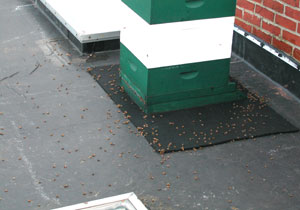
Soon after the new roof was installed, I noticed bee bodies piling up, mostly around Twain. It was hard to avoid the question: "Is the new roof killing the bees?" It was even harder to figure what the solution would be if I have an apicidal roof.
This is going to be one of those posts with lots of questions and muttering and head scratching, just so you are warned.
Initially, the first issue that hit me was that mostly Twain was affected. There were some dead bees around Wilde, but only in numbers that I associate with end-of-the-season dwindling. If the roof were killing bees, wouldn't both hives be affected similarly?
I remembered that Twain, being heavier, took a few extra shots while being moved for the construction, and also that with its larger population, that colony would show dwindling more obviously. However, this was very out of proportion. Was it robbing? David, the pumpkin-farming beekeeper for whom I am doing a web site, says it is always his strongest, largest hives that have the hardest transition to winter, often getting robbed in the process. Whenever I see robbers, I always wonder whether old Queen Eleanor and the girls are still around nearby, somehow surviving wild.
Finally, I remembered that at this time last year came the Time of the Creeping, when hundreds of sick, mite-bitten bees came crawling out of Twain. I "saved" them then by knocking down the mites, but the virus that caused the illness is still in there, mixed in the wax and the propolis and the bees' bodies themselves. With their increased cold weather confinement, was there an epidemic of Paralytic Mite Syndrome (PMS)?
To come up with any answer at all, it was necessary to get more data. The first thing was to sweep away all the existing bee bodies, and determine whether the die-off was continuing. This turned out to be hard to manage, because just enough rain fell at just the wrong time to make it hard for me to sweep around the hives. I needed to sweep in the twilight because waving big sticks around beehives is considered QUITE the provocation during business hours, and any later I would be unable to see a thing. I needed the roof to be dry, or I would just sweep wide swathes of mashed bee around the place – very disconcerting and sad.
My chance came about a week ago, and I swept the dead girls off to the other side. When dealing with dead bees, I try to toss their bodies up into the air, toward the sun, a kind of last flight and a thank you for all their hard work in their short lives. Sweeping them into a dust pan was a heartsore thing.
As of now, it appears that the bee death has stopped. If the roof was off-gassing, either temperature or time has caused that to diminish. If PMS was killing the bees, this month's oxalic acid application has perhaps curtailed its spread. There is still a daunting mite drop. If the dead are actually robbers, the thieving colony has either clustered now or lost too many bees to continue. Our weather has been awfully warm, too, with sudden cool-downs, and it is possible that the bees got caught outside at the wrong time. We had one afternoon when the temperature dropped 40 degrees F in two hours.
I keep wishing that it was more clear what a "normal" year would look like: to have an expectation of when dwindling would occur and what it would look like, to understand how heavy with stores the hives should be, and how much activity I should be seeing. But there is no such thing as a normal year, and urban rooftops are not often factored into your "normal" beekeeping expectations. These weird warm days are actually horrid for the bees in a light honey year like this, too, because they keep flying (and, potentially, trying to rear young) when there is almost nothing for them to forage.
But it must be said that the news is good, though answers are scarce. Whatever killed bees seems to have stopped, and there are still enough girls to make the winter. I will have a job of knocking down mites and topping off stores, but I like having something to do for them.
No comments:
Post a Comment